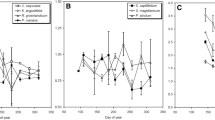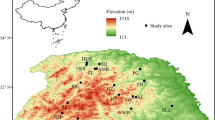Abstract
Foliar δ15N, %N and %P in the dominant woody and herbaceous species across nutrient gradients in New Zealand restiad (family Restionaceae) raised bogs revealed marked differences in plant δ15N correlations with P. The two heath shrubs, Leptospermum scoparium (Myrtaceae) and Dracophyllum scoparium (Epacridaceae), showed considerable isotopic variation (−2.03 to −15.55‰, and −0.39 to −12.06‰, respectively) across the bogs, with foliar δ15N strongly and positively correlated with P concentrations in foliage and peat, and negatively correlated with foliar N:P ratios. For L. scoparium, the isotopic gradient was not linked to ectomycorrhizal (ECM) fractionation as ECMs occurred only on higher nutrient marginal peats where 15N depletion was least. In strong contrast, restiad species (Empodisma minus Sporadanthus ferrugineus, S. traversii) showed little isotopic variation across the same nutrient gradients. Empodisma minus and S. traversii had δ15N levels consistently around 0‰ (means of −0.12‰ and +0.15‰ respectively), and S. ferrugineus, which co-habited with E. minus, was more depleted (mean −4.97‰). The isotopic differences between heath shrubs and restiads were similar in floristically dissimilar bogs and may be linked to contrasting nutrient demands, acquisition mechanisms, and root morphology. Leptospermum scoparium shrubs on low nutrient peats were stunted, with low tissue P concentrations, and high N:P ratios, suggesting they were P-limited, which was probably exacerbated by markedly reduced mycorrhizal colonisations. The coupling of δ15N depletion and %P in heath shrubs suggests that N fractionation is promoted by P limitation. In contrast, the constancy in δ15N of the restiad species through the N and P gradients suggests that these are not suffering from P limitation.




Similar content being viewed by others
References
Clarkson BR, Schipper LA, Clarkson BD (2004a) Vegetation and peat characteristics of restiad bogs on Chatham Island (Rekohu), New Zealand. N Z J Bot 42:293–312
Clarkson BR, Schipper LA, Lehmann A (2004b) Vegetation and peat characteristics in the development of lowland restiad peat bogs, North Island, New Zealand. Wetlands 24:133–151
Emmerton KS, Callaghan TV, Jones HE, Leake JR, Michelsen A, Read DJ (2001) Assimilation and isotopic fractionation of nitrogen by mycorrhizal and nonmycorrhizal subarctic plants. New Phytologist 151:513–524
Erskine PD, Bergstrom DM, Schmidt S, Stewart GR, Tweedie CE, Shaw JD (1998) Subantarctic Macquarie Island–a model ecosystem for studying animal–derived nitrogen sources using 15N natural abundance. Oecologia 117:187–193
Falkengren-Grerup U, Michelsen A, Olsson MO, Quarmby C, Sleep D (2004) Plant nitrate use in deciduous woodland: the relationship between N, 15N natural abundance of forbs and soil N mineralisation. Soil Biol Biochem 36:1885–1891
Feller IC (1995) Effects of nutrient enrichment on growth and herbivory of dwarf red mangrove (Rhizophora mangle L.). Ecol Monogr 65:477–505
Fry B, Bern AL, Ross MS, Meeder JF (2000) δ15N studies of nitrogen use by the red mangrove Rhizophora mangle L. in South Florida. Estuarine Coastal Shelf Sci 50:291–296
Goerick R, Montoya JP, Fry B (1994) Physiology of isotopic fractionation in algae and cyanobacteria. In: Lajtha K, Michener R (eds) Stable isotopes in ecology and environmental science. Blackwell Science, Oxford, UK, pp 187–221
Güsewell S, Koerselman W (2002) Variation in nitrogen and phosphorus concentrations of wetland plants. Perspect Plant Ecol Evol Systematics 5:37–61
Hobbie EA, Macko SA, Shugart HH (1999) Interpretation of nitrogen isotope signatures using the NIFTE model. Oecologia 120:405–415
Kohzu A, Tateishi T, Yamada A, Koba K, Wada E (2000) Nitrogen isotope fractionation during nitrogen transport from ectomycorrhizal fungi, Suillus granulatus, to host plant, Pinus densiflora . Soil Sci Plant Nutrition 46:733–739
Kohzu A, Matsui K, Yamada T, Sugimoto A, Fujita N (2003) Significance of rooting depth in mire plants: evidence from natural 15N abundance. Ecol Res 18:257–266
Lamont BB (1982) Mechanisms for enhancing nutrient uptake in plants, with particular reference to Mediterranean South Africa and Western Australia. Bot Rev 48:597–689
McGonigle TP, Miller MH, Evans DG, Fairchild GL, Swan JA (1990) A new method which gives an objective measure of colonization of roots by vesicular-arbuscular mycorrhizal fungi. New Phytologist 115:495–501
McKee KL, Feller IC, Popp M, Wanek W (2002) Mangrove isotopic (δ15N and δ13C) fractionation across a nitrogen vs. phosphorus limitation gradient. Ecology 83:1065–1075
Meney KA, Pate JS (1999) Seasonal growth and nutrition of Restionaceae. In: Meney KA, Pate JS (eds) Australian Rushes: biology, identification and conservation of Restionaceae and allied families. University of Western Australia Press, Nedlands, pp 85–96
Meney KA, Dixon KW, Scheltema M, Pate JS (1993) Occurrence of vesicular mycorrhizal fungi in dryland species of Restionaceae and Cyperaceae from south-west Western Australia. Austr J Bot 38:733–737
Michelsen A, Schmidt IK, Jonasson S, Quarmby C, Sleep D (1996) Leaf δ15N abundance of subarctic plants provides field evidence that ericoid, ectomycorrhizal and non- and arbuscular mycorrhizal species access different sources of soil nitrogen. Oecologia 105:53–63
Michelsen A, Quarmby C, Sleep D, Jonasson S (1998) Vascular plant δ15N natural abundance in heath and forest tundra ecosystems is closely related with presence and type of mycorrhizal fungi in roots. Oecologia 115:406–418
Montoya JP, McCarthy JJ (1995) Isotopic fractionation during nitrate uptake by phytoplankton grown in continuous culture. J Plankton Res 17:439–464
Moyersoen B, Fitter AH (1999) Presence of arbuscular mycorrhizas in typically ectomycorrhizal host species from Cameroon and New Zealand. Mycorrhiza 8:247–253
Nadelhoffer KG, Shaver G, Fry B, Giblin A, Johnson L, McKane R (1996) 15 N natural abundances and N use by tundra plants. Oecologia 107:386–394
Pearson J, Wells DM, Seller KJ, Bennett A, Soares A, Woodall J, Ingrouille MJ (2000) Traffic exposure increases natural 15N and heavy metal concentrations in mosses. New Phytologist 147:317–326
Pennock JR, Velinsky DJ, Ludham JM, Sharp JH (1996) Isotopic fractionation of ammonium and nitrate during uptake by Skeletonema costatum: implications for 15N dynamics under bloom conditions. Limnology and Oceanography 41:451–459
Reed ML (1987) Ericoid mycorrhiza of Epacridaceae in Australia. In: Sylvia DM, Hung LL, Graham JH (eds) Mycorrhizae in the next decade. Institute of Food and Agricultural Sciences, Gainesville, p 335
Schipper LA, McLeod M, Clarkson BR, Vojvodic-Vukovic M, Taylor M (1998) Gradients of microbial biomass, anaerobically mineralizable N and some physical properties in a restiad peat bog. Int Peat J 8:71–75
Schmidt S, Stewart GR (1997) Waterlogging and fire impacts on nitrogen availability and utilization in a subtropical wet heathland (wallum). Plant Cell Environ 20:1231–1241
Schultze ED, Chapin FS III, Gebauer G (1994) Nitrogen nutrition and isotope differences among life forms at the northern treeline of Alaska. Oecologia 100:406–412
Tester M, Smith SE, Smith FA (1987) The phenomenon of non-mycorrhizal plants. Can J Bot 65:419–435
Verhoeven JTA, Koerselmann W, Meuleman AF (1996) Nitrogen- or phosphorus-limited growth in herbaceous, wet vegetation: relations with atmospheric inputs and management regimes. Trends Ecol Evol 11:494–497
Yoneyama T, Matsamaru T, Usui K, Engelaar WMHG (2001) Discrimination of nitrogen isotopes during absorption of ammonium and nitrate at different nitrogen concentrations by rice (Oryza sativa L.) plants. Plant Cell Environ 24:133–139
Acknowledgments
We thank Neil Fitzgerald and Corinne Watts for field assistance, Maja Vojvodic-Vukovic for technical expertise, and Anjana Rajendram, Waikato Stable Isotope Unit, for stable isotope analysis. Bruce Clarkson, Bill Lee and two anonymous referees provided useful comments on the manuscript. This research was partly funded by the New Zealand Foundation for Research, Science and Technology (contract C09X0205).
Author information
Authors and Affiliations
Corresponding author
Additional information
Communicated by Jim Ehleringer
Rights and permissions
About this article
Cite this article
Clarkson, B.R., Schipper, L.A., Moyersoen, B. et al. Foliar 15N natural abundance indicates phosphorus limitation of bog species. Oecologia 144, 550–557 (2005). https://doi.org/10.1007/s00442-005-0033-4
Received:
Accepted:
Published:
Issue Date:
DOI: https://doi.org/10.1007/s00442-005-0033-4




